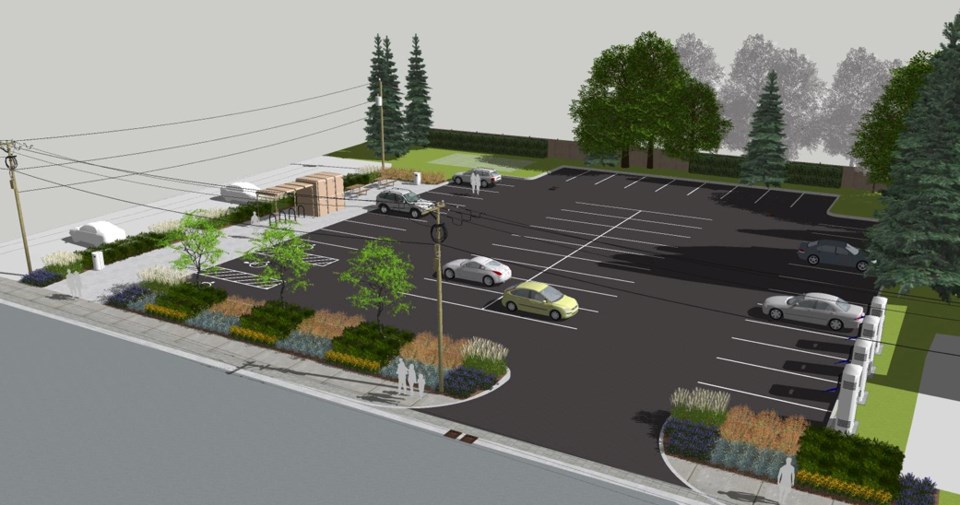Projected costs for the new Arthur Street parking lot have doubled, leading The Town of The Blue Mountains (TBM) staff to ask council’s permission for additional funding for the project.
Council initially approved $410,000 for the project in the 2021 budget, but town staff asked for the approval of an additional $329,500 at council Jan. 19.
Including funds spent for engineering the project, the total cost now sits at an estimated $840,000.
The site for the new parking lot, at 15 and 17 Arthur Street West, was purchased by the town in 2019 for $875,000, and construction is anticipated to begin in spring 2022.
The parking lot was designed to be feature-rich and includes numerous green, environmentally-friendly design features.
“This parking lot isn't a standard parking lot that you would have outside an area, behind a building,” said Jamie Witherspoon, president of WT Infrastructure Solutions, the engineering firm that designed the parking lot. “This is a pretty important area, so the intended design is sort of to deal with that, in terms of making it look like it fit in the area.”
The design includes solar lighting, six paid bicycle lockers, 26 planted trees and 114 planted shrubs, oil and sediment interceptors, and conduits for potential electric vehicle charging stations in the future.
Conventional bicycle racks will be available in addition to the lockers, and the lot will include 49 parking spaces.
Some of the more costly features include the solar lighting, at $80,000, and the bicycle lockers, at $50,000.
The town also estimates a cost of $90,000 to deal with excess soil created by the project, due to Ontario’s new Regulation 406/19, which took effect on Jan. 1 and requires excess soil generated by development to meet updated quality standards.
“When we purchased this piece of property, the regulations on excess soil were not in place, and, no different than what the developers of the community are dealing with, we as a municipality are dealing with the same thing,” said CAO Shawn Everitt.
Several members of council were concerned with the ask for an additional $329,500.
“We're talking about $800,000 for a parking lot, and that's just not sitting that well,” said Deputy Mayor Peter Bordignon.
“I'm really, extremely uncomfortable, and I think we may have designed something that looks absolutely spectacular but is outside of our budget,” said Councillor Rob Sampson.
“We just had a presentation from some local business people who are struggling to survive, and to do this and slap this on the tax base, I think it’s the wrong time to be doing this. I understand that a large chunk of this will be funded from reserves, but those reserves were at one time drawn from the pocketbooks of taxpayers.”
Council members discussed scaling back some of the project’s features to save money, including potentially using gravel in lieu of asphalt for the lot.
“I live on a gravel road, we will always have a gravel driveway. I don't have a problem with the aesthetics of gravel,” said Councillor Andrea Matrosovs.
“Yes, the prices have increased over the past couple of years, and the [excess soil regulation] is certainly something that we weren't necessarily anticipating … but if we had known these costs back then I don't think we would have been necessarily making the same decision.”
However, staff argued that gravel would not be the best option.
“Our zoning bylaw has pretty descriptive and guiding words about how we deal with parking lots, and gravel is not one of the preferential materials that we use,” said director of planning and development services Nathan Westendorp. “So part of this is leading by example and living by our own rules.”
Council also asked about the parking lot’s potential for revenue generation, given its parking spaces and bicycle lockers, but staff were not able to give hard numbers due to remaining decisions about the lot’s fee structure.
“You could see $260,000 in annual revenue, but that might be high and then that doesn't necessarily factor into allowing residents to park there for free,” said director of operations Shawn Carey. “I think there is cost recovery, [but] it's a matter of how quickly we'll get there, and then that's all based on the various options around fee structure, and who would be required to pay.”
Councillor Paula Hope argued that council should be reluctant to slash too many features from the new parking lot.
“We are a tourist region, we are four seasons,” she said. “I think we need to have the cleanliness of the presentation of the asphalt in a downtown facility, so I don't think we should mess with that. It's marketing, and a good investment in marketing always pays off exponentially. We want to recover effectively - we need to have the look and feel of an inviting town presentation.”
Council moved for staff to prepare an additional report for consideration, which will include alternative options for the parking lot’s features, potential cost recovery scenarios, sustainability features, and maintenance costs.



